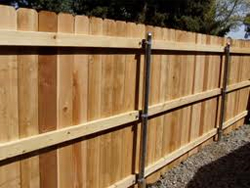It is relatively simple to complete your own DIY fencing project. However, if you want to build a fence in your yard, you must do it correctly. Therefore, if you have no handyman skills, you should first learn about the basics of DIY fencing and plan a project that you feel comfortable working on. If you need any help locating tools and supplies, you can find them at your local home improvement store of fencing company.

Laying the Fence Line
The first step in any DIY fencing project is laying the fence line. The fence must sit straight so you will need to make a plumb line alongside the fence line. And the measurements have to be exact; otherwise, you will make more work for yourself.
After the fence line is marked, and you have ensured that the line is straight, check to make sure there are no obstructions near the intended post holes. Some obstructions to clear are:
* Areas
* Hard Ground
* Rocks.
It is best to put the fence on malleable ground so you will not have to put forth a ton of effort to install the supports.
Styles of DIY Fencing
No matter the material of the fence, all fencing consists of a support and frame system coupled with stable ground fittings. Some common DIY fencing materials include:
* Colorbond. These fences are large, single pieces that must be carefully handled during installation. Once a Colorbond fence is installed, it is difficult to move.
* Steel. Steel fencing is a frame-based fencing. This type of fence is typically made with chain-wire mesh or pre-cut pieces.
* Timber. A timber fence may be solid or picket style. Either way, you will have to assemble and systematically install a timber fence.
Installing the Actual Fence
In any DIY fencing project, the biggest part of the job is installing the actual fence. Before anything else is done during a fencing installation project, you must install the supports. Once the support posts are in the ground, be sure they do not move at all before continuing on with the next step.
After you are sure the support posts are firm, the next DIY fencing installation step is adding the fence beams. Steel frames usually come with instructions. If you are making a timber fence, the crossbeams are attached. All crossbeams need to be level and straight; otherwise, they will put too much stress on the body and supports of the fence.
Finally, you can install the fencing material. All pieces of the fence should fit firmly to the crossbeams. If any of the materials appear weak or damaged, do not use them. Otherwise, you will have to replace them early on.
DIY Fencing Quality Checks
No matter what type of DIY fencing project you are undergoing, the fence should lay systematically. Since you are managing the entire project, keep careful track of all materials. And if any issue should arise, immediately address them before continuing on with your DIY fencing project.
